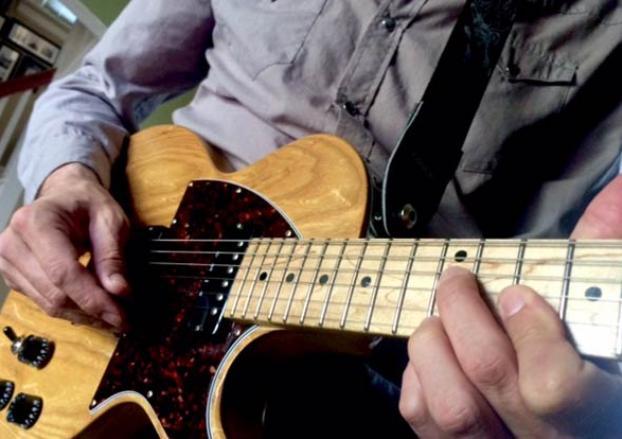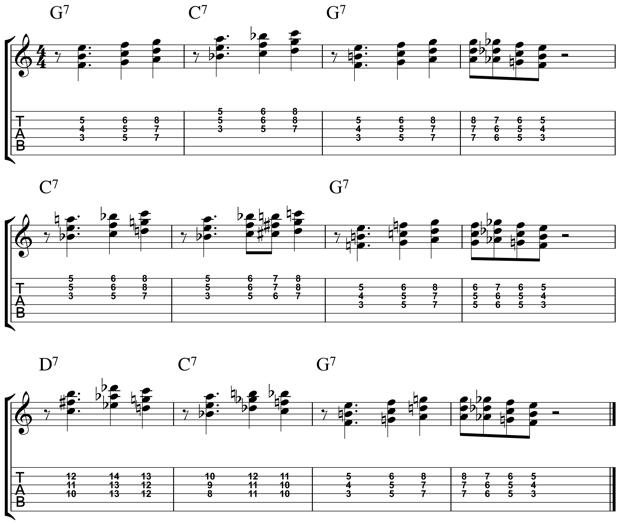Modernize Your Jazz Blues Chords

Comping over a jazz blues chord progression is something every jazz guitarist needs to be able to do in order to function in a jam or gig situation.
While many of us study traditional chord shapes such as 3rds and 7ths, Drop 2 and Drop 3 chords over a jazz blues, sometimes we want to bring a more modern sound into our chord lines over this common jazz progression.
One of the best ways to modernize your jazz blues comping is to use 4th chords in your comping phrases, chords that are built by stacking 4th intervals rather than 3rds, as is the case in more traditional chord shapes.
In this lesson, you will learn how to play and apply 4th chords to the I7, IV7 and V7 chords of a blues progression in order to bring a modern vibe to your comping ideas, as well as learn a study that you can use to hear these shapes in a musical situation.
Modern Jazz Blues Chords Position 1
To begin, here are three 4th-chord shapes you can use over the three chords in a 12-bar G blues, using the I7, IV7 and V7 chords, which are G7-C7-D7 in this key.
Notice how each chord is built by starting on a chord tone, 7th, root and 2nd in this case, and then stacking 4th intervals on top of these initial chords.
All the latest guitar news, interviews, lessons, reviews, deals and more, direct to your inbox!
This stacking of 4th intervals, which we call 4th chords, creates that cool, modern sound in your chord voicings, and it is the reason these chords can make a jazz blues tune sound modern when applied to those changes.
Once you have these shapes under your fingers, put on a G blues backing track and practice applying them to the I7, IV7 and V7 chords over that tune.

Modern Jazz Blues Chords Position 2
To help you expand upon these chord shapes in your practice routine, here are the same notes, but now in a different position of the fretboard.
Notice that the G7 chord now uses the shapes from the C7-D7 chords in the first example, and the C7-D7 chords now use the same shapes as the G7 chord in the previous example. This will allow you to quickly move these shapes around the fretboard as you don’t have to learn new chords, you just have to practice playing them in a second position on the neck.
Once these chords are familiar, put on a backing track and comp over those chords using both positions on the fretboard to create your lines and phrases.

Chromatic Passing Chords
Besides playing these three chords over each change in the blues progression, you also can add a passing chord between the 2nd and 3rd shapes to bring a sense of chromaticism to your chord lines. Because the 2nd and 3rd chords have the same shape, and are two frets apart, you can fill in the space between those chords with a chromatic chord, which you can see and hear in the example below.
When applying these chromatic chords to your comping and chord soloing ideas, you don’t always have to play these chords in order, such as inside-outside-inside.
Instead, just think about the chromatic chords as creating tension, which you then need to resolve in your lines by moving to an inside chord by the end of your phrase.
Once you have explored the chord shapes below, put on a G blues backing track and comping over those changes using the following chord shapes to create you lines and phrases.

Modern Jazz Blues Comping Study
To finish your study of these three-note, modern-sounding jazz blues chords, here's a comping study written out over a 12-bar G blues that you can learn and explore in the practice room. Try memorizing this study and playing it along with a backing track, as well as writing out a chord study of your own using the shapes learned in this lesson.

Do you any questions about these modern jazz blues chords? Share your thoughts in the COMMENTS section below.
Matt Warnock is the owner of mattwarnockguitar.com, a free website that provides hundreds of lessons and resources designed to help guitarists of all experience levels meet their practice and performance goals. Matt lives in the UK, where he is a senior lecturer at the Leeds College of Music and an examiner for the London College of Music (Registry of Guitar Tutors).
Matt Warnock is the owner of mattwarnockguitar.com, a free website that provides hundreds of lessons and resources designed to help guitarists of all experience levels meet their practice and performance goals. Matt lives in the UK, where he teaches Skype guitar students all over the world, and is an examiner for the London College of Music (Registry of Guitar Tutors).
